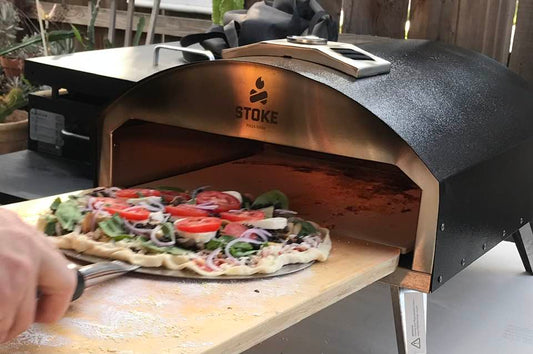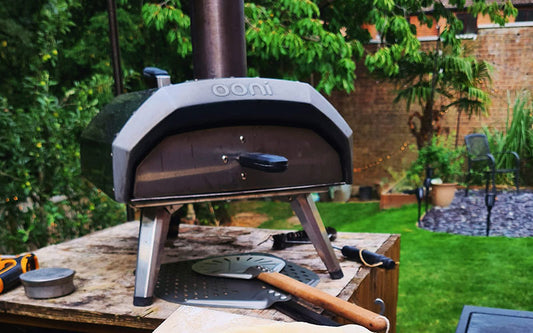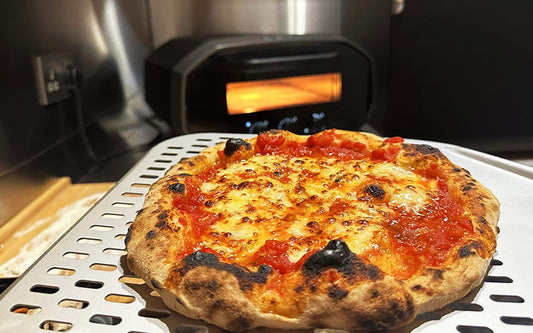Can you use a pizza stone on a gas grill to create that authentic, pizzeria-quality pie? Well, I love pizza, and I love grilling, so this is a topic that I’m passionate about. Today, I’ll explain why using a pizza stone on a gas grill can make your pizza taste better, cook faster, and look more authentic.
You can absolutely use a pizza stone on your gas grill! If done correctly, it will ensure your pizza cooks evenly with a light and crispy crust, thanks to that even heat distribution. Plus, it’s not just about pizza; you can grill up fantastic bread, roast veggies to perfection, and even whip up scrumptious desserts, all with that irresistible smoky flavor twist.
In this article, I’ll walk you through the ins and outs of using a pizza stone on a gas grill. We’ll explore the benefits along with step-by-step instructions. Let’s get started…
The Gas Grill Revolution: Elevating Your Pizza with a Stone
One of the biggest benefits of using a stone on your gas grill is that it creates even and fast heating for your pizza. A stone can reach high temperatures and retain them for a long time. This means that your pizza will bake evenly and quickly, without any cold or hot spots.

You’ll get a crunchy crust and gooey cheese in minutes. This is much better than using the grates directly, which can potentially cause uneven cooking and burning.
Crafting the Crispiest Crust: The Pizza Stone Effect
Another benefit of using a stone is that it removes excess moisture from the dough. This allows the crust to crisp up to perfection. A stone pulls out extra moisture from the pizza dough, making it less soggy and more crispy.
This also stops the dough from sticking to the grates, which can be hard to clean. You’ll get a perfect crust that is not too dry or too wet.
The Secret to Smoky, Charred Perfection in Pizza
A quality baking stone can produce a smoky, charred taste and appearance that you can’t get from an oven. You’ll get those nice grill marks and bubbles on your crust that make your pizza look like it came from a wood-fired oven. You’ll also get a delicious flavor that complements your toppings.
Using a pizza stone on a gas grill can improve your pizza’s flavor, texture, and appearance. It cooks pizza quickly and evenly, giving it a crisp crust and gooey cheese. Pizza stones can also impart a smoky, charred taste that is similar to wood-fired pizza.
To use a pizza stone on a gas grill, simply preheat the stone to 350-400 degrees Fahrenheit before placing your pizza on it. Use a pizza peel to transfer the pizza onto the stone, and cook for 10-15 minutes, or until the crust is golden brown and the cheese is melted and bubbly.
Here are some tips for using a pizza stone on a gas grill:
- Choose a pizza stone that is specifically designed for grilling.
- Preheat the pizza stone for at least 15 minutes before using it.
- Use a pizza peel to transfer the pizza onto and off the stone.
- Be careful not to overload the pizza stone.
- Don’t crowd the pizza stone with other food.
- Let the pizza stone cool completely before cleaning it.
With proper care, your pizza stone will last for many years.
Essential Considerations Before Using a Pizza Stone on a Gas Grill
Using a pizza stone on a gas grill offers fantastic results, but it comes with its own set of rules. Here’s everything you need to know before you get started:
Choosing the Ideal Pizza Stone: Size, Fit, and Durability
First things first, make sure you’ve got the right pizza stone for the job. Not all pizza stones are grill-ready, and some might not handle the heat. Always check the manufacturer’s recommendations to ensure your pizza stone can handle the grill.
🔍Next Read: Our Recommended Best Pizza Dough Press for 2024
Here are some factors to consider:
The Right Accessories for a Flawless Pizza Experience
You want a pizza stone that fits your grill and your pizza, striking that perfect balance. It shouldn’t overwhelm your grill, but it should comfortably accommodate your pizza. Consider whether round, square, or rectangular stones work best for your grill and pizza size.
Heat Endurance
Look for a pizza stone capable of withstanding high temperatures and thermal shocks. While ceramic and stone are common choices, their quality and durability can vary. A dense, heavy, and thick stone (at least 0.5 inches) is your best bet, though metal options are available, too.
Accessories
Think about investing in some helpful accessories like a pizza peel, cutter, or spatula. A pizza peel is a handy tool for sliding your pizza onto and off the stone. A pizza cutter makes slicing a breeze, and a pizza spatula helps you lift and serve your creation.
Preparing the Pizza Stone
- Next up, it’s crucial to prep your pizza stone before you start grilling. Properly preheating the stone is the key to achieving mouthwatering results.
- Place your stone on the grill when it’s turned off. This prevents sudden temperature changes that could cause it to crack.
- Crank up the grill to the highest settings. The pizza stone grill temperature should be ideally around 350-400 F.
- Allow the stone to heat up for at least 15 minutes before placing your pizza on it. This ensures it’s hot enough for that perfect cook.
Handling the Pizza Stone
Now, let’s talk about safely handling your pizza stone on the grill. Handling it incorrectly can be tricky and even hazardous. Here’s how to do it right:
Gear Up
Because the stone gets incredibly hot, protect your hands with oven mitts or gloves. When moving the pizza, use a peel or spatula.
Be Quick and Gentle
Transferring your pizza onto or off the stone requires swift, delicate movements. Leaving the grill lid open for too long can affect cooking, and exerting too much force on the pizza can lead to tears or slips.
✅Recommended: Best Pizza Turning Peel for Ooni, Gozney Dome and Roccbox
Don’t Rush Cleaning
After using the stone, let it cool completely on the grill or a heat-resistant surface before attempting to move or clean it.
Cleaning the Pizza Stone
Proper cleaning is crucial for maintaining performance and appearance while preventing damage. Follow these steps:
1. Scrape Off Residue: Once the stone cools down, use a spatula or scraper to remove any stubborn food or grease. Avoid using soap or detergent, as they can harm the stone and taint your pizza.
2. Rinse Sparingly: If your stone is exceptionally dirty, rinse it with water to remove any lingering residue. However, avoid soaking it, as excessive moisture can lead to cracking later. Dry the stone thoroughly with a cloth or paper towel.
🔍Next Read: How to Clean Ooni Pizza Stone?
3. Season It: Periodically season your stone with vegetable oil to prevent sticking. Heat it in the oven or on the grill for an hour, let it cool, and wipe away any excess oil.
4. Store Wisely: When not in use, store your pizza stone in a dry spot. Keep it away from moisture and extreme temperatures. It could be on the grill, in the oven, or neatly tucked away in a cabinet.
Alternative Solutions: Beyond the Traditional Pizza Stone for Gas Grills
If you don’t have a pizza stone for grilling, no worries. You can still make delicious pizza on your grill with some alternatives. Here are two options that you can try:
- Pizza Steel: Pizza steels not only facilitate rapid and even heating, but they are also highly resistant to cracking or breaking. Keep in mind that it’s a bit pricier and heavier than a pizza stone. Moreover, they may need some occasional seasoning and maintenance.
- Grill-Specific Pizza Pans: These pans are tailor-made for grilling pizza. They feature small holes that allow heat and smoky goodness to infuse your crust. They’re also non-stick, easy to clean, and budget-friendly. However, they might not reach the same high temperatures as a pizza stone or steel and may not achieve that coveted charred effect.
Keeping Your Pizza Stone Intact: Tips to Prevent Cracking on a Gas Grill
While you certainly can use a pizza stone on a gas grill, it does come with the challenge of preventing it from cracking due to sudden temperature changes. This phenomenon is also known as thermal shock. Here are some practical tips to avoid pizza stone cracking when grilling:

🔥Choose a Grill-Safe Stone: Ensure your pizza stone is grill-safe by checking the manufacturer’s specifications. Look for stones designed for grilling purposes.
🔥Start with a Cold Grill: Place your stone on the grill while it’s off, preventing thermal shock. Never put a cold or room temperature stone on a moderately hot grill to avoid potential damage.
🔥Preheat Gradually: Gradually preheat your grill and stone. Set your grill to medium heat (around 350°F) and allow the stone to warm up for at least 15 minutes before placing your pizza. Avoid extreme heat levels to prevent uneven heating and potential cracks.
🔥Keep it Away from Flames: If you’re using a gas grill, ensure the stone doesn’t directly touch the burner flames. This can lead to overheating and cracking. Use a heat diffuser or a metal tray to shield the stone.
🔥Cool Before Handling: After grilling, let the stone cool completely before attempting to move or clean it. This crucial step helps prevent any cracking or warping issues and keeps your stone in good shape.
In Conclusion
I hope this article has helped you understand the benefits of using a pizza stone on a gas grill and how to do it properly. A pizza stone can make a big difference in the quality and taste of your pizza, and it’s also fun to use. Try it out and see for yourself!




